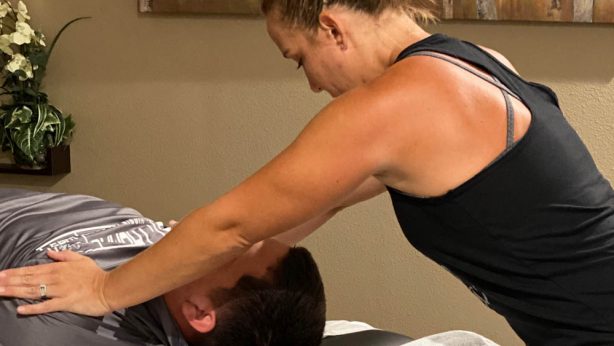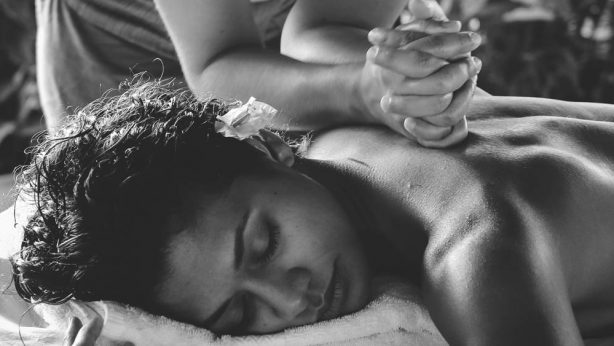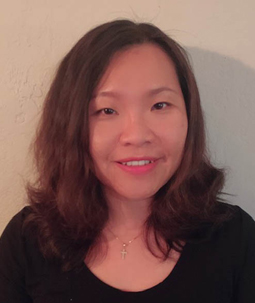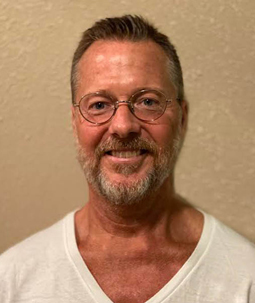Improve Muscle Performance with Passive Stretching Therapy

How does passive stretching work? Reach up and rotate your arm to stretch it out. Try to explore the full range of motion from your shoulder. Did you grab your elbow? Did you use a chair, wall, or doorway to pull just a little further? This is what is known as passive stretching. There are two types of stretching when working out stiffness and kinks in your muscles: active stretching and passive stretching. If you swing your arms wide using motion to pull and un-knot your joint, that is active stretching. Passive stretching is when you can relax the muscle while an outside force pulls for you. There is a great deal of value in this technique Part of that is because you do not have to exert the force on yourself.
If you’ve ever tried to massage your own stiff shoulders, you know the difference between a tense massage and a relaxed one. Passive stretching uses the same principles to pull your muscles and joints to their full extension, erasing the kinks and relaxing the tension without creating more tension through self-exertion or control.
When that type of stretching is done by someone else, it becomes a form of therapy. This is where a therapist comes into play. They can help you regain your optimal range of motion and tension-free mobility by applying professional passive stretching.
Why Work With a Therapist for Stretching?
Why do you want a therapist for stretching? This is a reasonable question to ask, as everyone can do some passive stretching on their own. Grabbing your elbow or using a wall to stretch out your shoulders, for example, or propping your foot on a bench to stretch your hamstring. But only another person can therapeutically operate your joints and muscles to the full, optimal range of motion.
If you’ve ever had a friend or physical therapist help you stretch out, you may already know the difference. There are some angles you just can’t achieve on your own. You also cannot fully relax while stretching out yourself, even using walls and furniture. A stretching therapist can help you work out tension, identify knots, and safely stretch out at every possible angle while you focus on letting your body relax into its proper alignment when the tension is removed.
Who Benefits from Passive Stretching?
The easy answer is “Everyone”. However, some have more to gain because their bodies are put through greater stress. Athletes and those with injuries that create tension and stiffness both benefit from passive stretching therapy. If you’re feeling tense or like their mobility is limited due to stiffness in your joints, simple stretches may alleviate this. In the event it doesn’t, you should consider passive stretching therapy a possible solution.
How Often Should You Consider Passive Stretching?
This stretching technique is something you can (and should!) do at home every day. It’s a great way to warm up and “warm down” from exercise to stay limber. It also helps to reduce aches after you’ve worked out muscle groups. Without exercise, we would still recommend passive stretching three times a week. This practice will help your muscles and joints remain free of tension during your daily routine.
If you are experiencing aches, stiffness, or limited mobility, that is when to book a passive stretching therapy. Many athletes will book passive stretching as part of their training routine. This helps to maintain optimal mobility without stiffening up during post-workout recovery.
Those who have experienced injuries may also seek passive stretching therapy as a weekly to monthly part of their healing. Passive stretching can help to slowly regain range of motion and help new muscle and tendon tissue to grow long instead of short.
What Can I Expect from Passive Stretching Therapy?
During a passive stretching session, your therapist will ask you questions about how your muscles, joints, and daily mobility have been while gently operating specific joints to help relax tension and explore your full range of motion. Your therapist will likely rotate your shoulders and head. You may be guided to sit or lie down to carefully twist your spine to one side and then the other. They may help you press and stretch your legs and to rotate each joint until it is fully mobile and at ease.
Passive stretching therapy tends to be slow-paced. Your therapist may place one hand on your joint to better feel if there is tension or crunching as you work. Communication is also important. Be sure to communicate when and where you feel tension, discomfort, or resistance. A stretching therapy is similar to massage, but also involves teamwork to ensure your therapist provides the best results for your body’s needs.
Book Passive Stretching Therapy Before the Holidays begin.
Whether you are sore from exercise, injury, or the tension of daily work, we can help. You can book a passive stretching therapy session before the holidays begin to face the bustle and family time feeling refreshed and limber. Go to our Contact page and choose “Pro-Stretch” for the subject. When you book with our trained and certified staff you’ll discover the benefits of passive stretching therapy for yourself.








